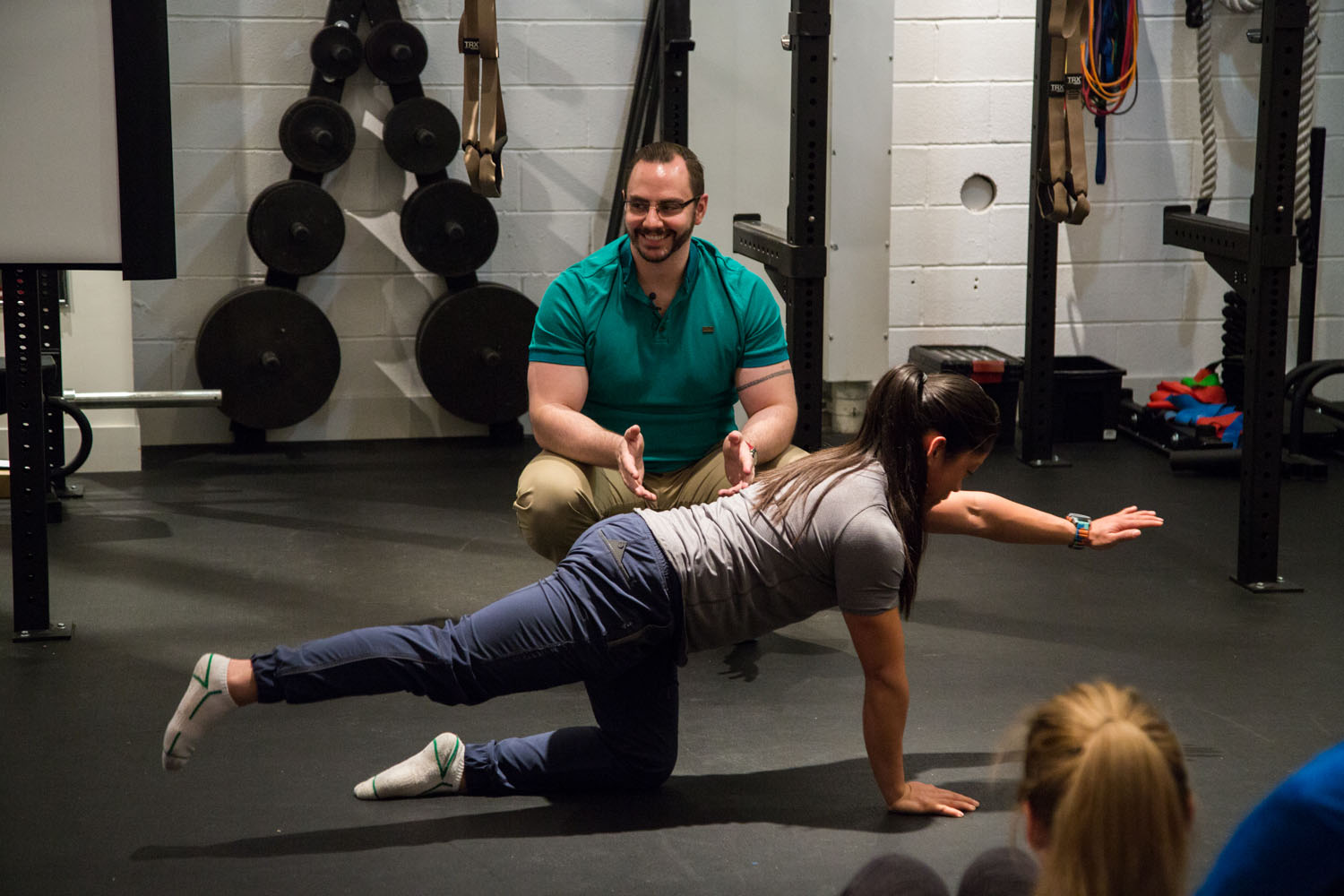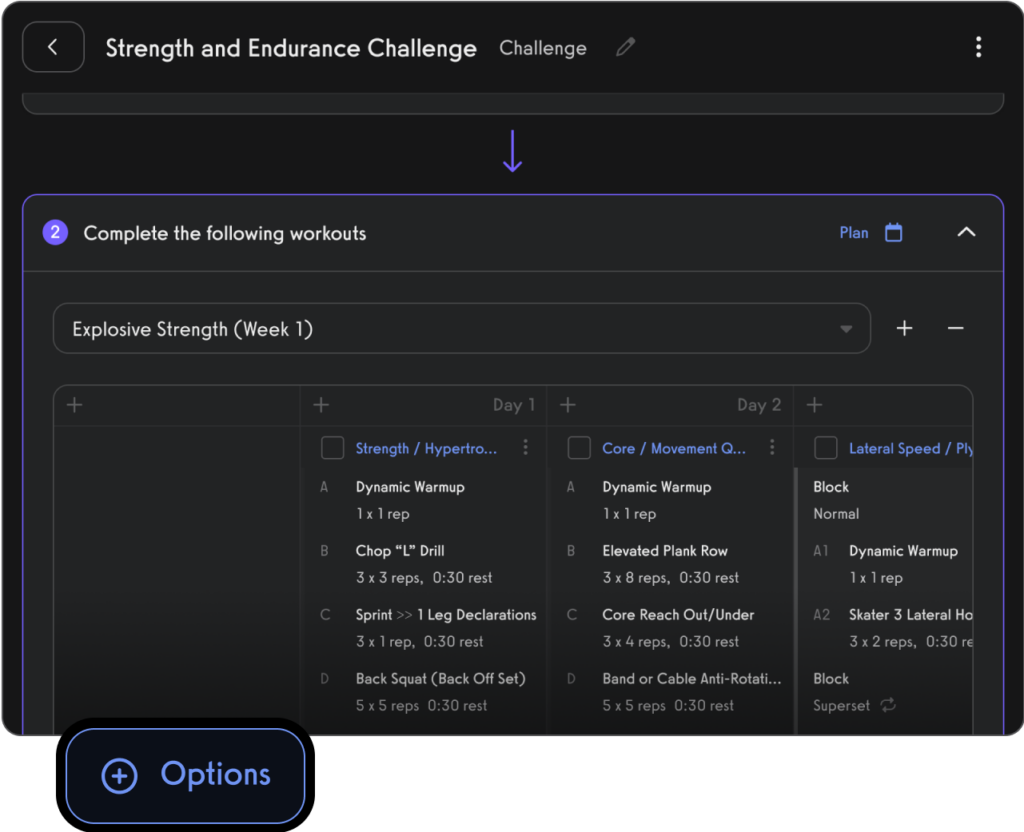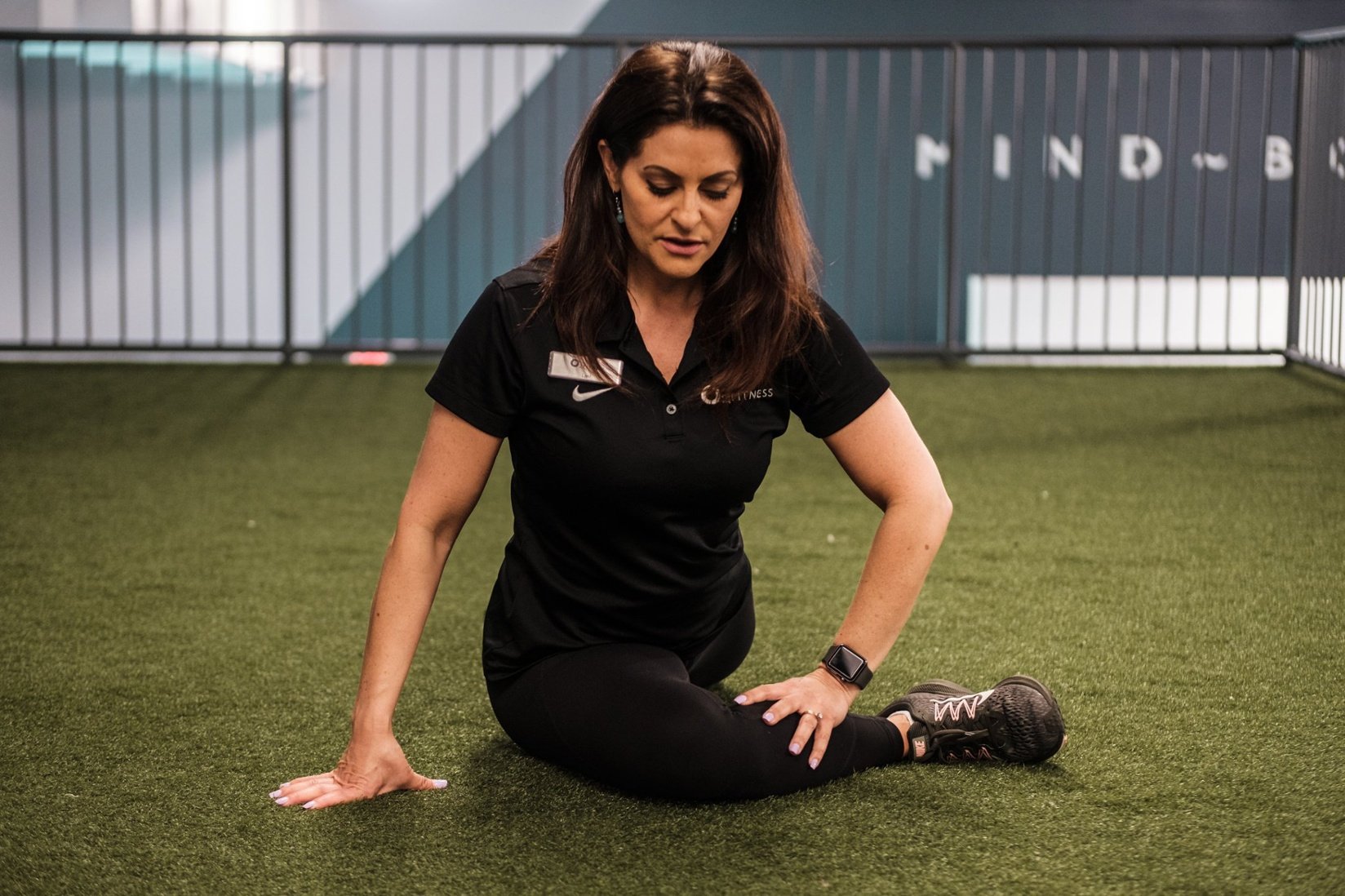25 Best Personal Trainer Challenge Ideas for Clients
Read our list of the best personal trainer challenge ideas for clients to motivate your clients, increase the personal training session fun quotient, and take the best fitness challenge ideas for a gym and use them for your personal training clients. Learn how to run a fitness challenge (and how to run an online fitness challenge) and then use these creative PT client challenge ideas to add some variety to your personal training session ideas.
Looking for new and exciting personal training challenge ideas? This article provides a comprehensive list of creative and effective personal trainer fitness challenges for clients to help you take your client’s fitness journey to the next level. Make sure and use the best fitness challenge software for gyms—all part of the best gym management software and best personal training management software platform: Exercise.com.

25 Personal Trainer Challenge Ideas for Clients
- 10,000 Steps Challenge: Encourage clients to hit 10,000 steps daily for a month.
- Plank Progression: Start with 30 seconds and add 10 seconds daily.
- Daily Stretch Challenge: 10 minutes of stretching every day.
- Vegan Week: Encourage clients to try veganism for a week.
- Mountain Climbers Madness: 100 mountain climbers daily.
- Outdoor Adventure Week: Incorporate outdoor exercises like hiking or trail running.
- Push-up Progression: Begin with 5 and add 2 more daily.
- Water Intake Challenge: Aim for 8 glasses daily.
- Meditation and Mindfulness: 10 minutes of meditation post-workout.
- Squat Challenge: Start with 20 squats and increase by 5 daily.
- High-Intensity Interval Week: HIIT workouts 5 times a week.
- Sleep Challenge: Aim for 8 hours of sleep daily.
- Jump Rope Revival: 10 minutes of jump rope daily.
- No Sugar Challenge: Eliminate added sugars for a month.
- Core Strengthening Month: Core exercises daily.
- Runners’ Week: Set a weekly mileage goal.
- Yoga Challenge: A new yoga pose every day.
- Active Commute: Bike or walk to work daily.
- Dance Off Week: Dance workouts every day.
- Resistance Band Resurgence: Incorporate resistance bands into workouts.
- Swim Challenge: Set weekly lap goals.
- Clean Eating Month: Focus on whole, unprocessed foods.
- Burpee Blast: Start with 10 burpees and add 2 daily.
- Strength Training Series: Focus on compound lifts.
- Mindful Eating Week: Document and reflect on daily food intake.
Challenges are an effective way to keep clients engaged and motivated. By crafting well-thought-out challenges, personal trainers can ensure clients get results and have fun at the same time.
Read More:
- Fitness Challenge Template
- How to Run a Fitness Competition
- Best Gym Leaderboard Software
- Virtual Fitness Challenge Ideas
Using Exercise.com to Create Client Fitness Challenges

In today’s digitally-driven fitness landscape, leveraging technology is no longer optional—it’s essential. For personal trainers, platforms like Exercise.com offer a comprehensive solution to manage and scale their businesses effectively. With its robust features, from workout plan creation to client management, Exercise.com empowers trainers to deliver unparalleled service to their clients. By integrating this platform into your fitness challenge designs, you not only streamline the process but also enhance the client experience.

How to Design Effective Fitness Challenges for Your Clients
Crafting a successful fitness challenge for your clients is more than just setting a goal and pushing them to achieve it. It’s about understanding their unique needs, keeping them motivated, and providing them with a structured path to success. Here’s a step-by-step guide for personal trainers on creating a captivating fitness challenge:
1. Define the Challenge Objectives
Before diving in, determine what the challenge aims to achieve. Are your clients aiming for weight loss, muscle gain, improved flexibility, or perhaps a mix? Tailoring the challenge to fit these objectives will make it more effective and engaging.
2. Determine the Duration
Decide on the challenge’s length. Short-term challenges can create quick wins and boost motivation, while longer-term challenges can foster discipline and lead to significant transformations.
3. Design the Activities
Craft a mix of exercises that cater to your clients’ goals. Ensure there’s variety to prevent monotony and ensure that exercises are adaptable to different fitness levels.
4. Implement Tracking Mechanisms
Incorporate tools the comprehensive Exercise.com platform or apps like Strava, Nike Training Club, or MyFitnessPal to track progress. This not only keeps clients accountable but also provides a visual representation of their achievements.
5. Foster a Supportive Environment
Encourage clients to share their progress, challenges, and achievements. A supportive community can be a game-changer in ensuring challenge completion.
6. Overcome Plateaus
Introduce new exercises or modify intensity levels to keep clients progressing. Periodically change routines to prevent adaptation and ensure continuous improvement.
7. Celebrate Achievements
Always acknowledge and celebrate your clients’ milestones, no matter how small. This boosts their confidence and encourages them to push harder, helping them remain consistent in their fitness journeys, pushing them closer to their goals. Remember, the key is to keep it fun, engaging, and rewarding.
In the realm of fitness, personal trainer challenges have become an integral component for clients seeking to push their limits and achieve their health and wellness goals. These challenges not only provide a sense of accomplishment but also serve as powerful motivators, pushing individuals beyond their comfort zones. By incorporating various challenges into a fitness routine, personal trainers can help clients enhance their physical capabilities, boost confidence, and foster a deeper understanding of their own potential.
Importance of Personal Trainer Challenges for Clients
Personal trainer challenges play a crucial role in the overall success of clients’ fitness journeys. When embarking on such endeavors, individuals are often faced with mental and physical barriers that prevent them from reaching their fullest potential. However, engaging in structured challenges under the guidance of a skilled personal trainer can help break through these barriers.
One key aspect is the element of accountability that these challenges bring to clients’ lives. With clear goals to work towards, individuals are more likely to stay committed and dedicated to their fitness regimen.
The presence of a personal trainer also ensures proper form and technique during exercises, reducing the risk of injury while optimizing results. Furthermore, by participating in well-designed challenges tailored to individual needs and abilities, clients can experience progressive improvements in strength, stamina, flexibility, and overall athletic performance.
Benefits of Incorporating Challenges into Fitness Routines
The incorporation of challenges into regular fitness routines offers an array of benefits that extend beyond simple physical gains. Firstly, incorporating challenging exercises adds variety and excitement to workouts – making them far more enjoyable than mundane routines. This renewed enthusiasm helps combat workout monotony while keeping individuals engaged and motivated throughout each session.
A fundamental benefit lies in constantly pushing boundaries and surpassing previous limitations. By setting specific targets or benchmarks within these challenges (e.g., increasing weight, completing more repetitions), clients are encouraged to continuously strive for progress.
This progressive mindset promotes personal growth, not only in terms of physical capabilities but also mental resilience and determination. Moreover, challenges allow individuals to gain a deeper understanding of their bodies and capabilities.
By pushing beyond comfort zones and attempting new exercises or techniques, clients become more aware of their strengths and weaknesses. This self-awareness empowers them to make informed decisions about their training regimens, leading to better overall results.
Strength and Conditioning Challenges
When it comes to strength and conditioning challenges, personal trainers have an array of exercises at their disposal to push their clients to new heights. Push-up variations, such as diamond push-ups and decline push-ups, are excellent choices for targeting different muscle groups and increasing upper body strength. Diamond push-ups specifically engage the triceps more intensely, while decline push-ups place more emphasis on the chest.
These variations can be incorporated into a challenge where clients aim to increase the number of repetitions or maintain proper form for longer durations. In addition to push-up challenges, incorporating plank variations into training routines can greatly enhance core stability and overall strength.
Side planks engage the obliques, while plank with leg lifts adds an extra challenge by requiring core stabilization as one leg is raised off the ground. By setting goals for increasing duration or performing these plank variations with added difficulty (such as lifting weights on the back), clients can make steady progress in their overall core strength.
Squat challenges are another valuable component of strength and conditioning programs. Pistol squats – a single-leg squat where one leg is extended forward – not only develop lower body strength but also improve balance and stability.
Sumo squats, on the other hand, target different muscles by placing a wider stance and turning toes outward. An effective squat challenge might involve gradually increasing the number of pistol squats performed per leg or progressively adding weight to sumo squats over time.
Cardiovascular Challenges
To optimize cardiovascular endurance and elevate heart rate during workouts, personal trainers can incorporate interval training challenges into their clients’ routines. Tabata workouts are ideal for high-intensity interval training (HIIT) as they consist of short bursts of intense exercise followed by brief periods of rest. For example, clients might perform eight rounds of 20 seconds of maximum effort exercises (such as burpees or squat jumps) followed by 10 seconds of rest.
As clients progress, they can aim to complete more rounds or increase the intensity of each exercise. Stair climbing challenges offer a unique cardiovascular workout that targets the lower body muscles.
By timing stair sprints or incorporating step-up variations, personal trainers can challenge their clients to improve speed and endurance. For instance, clients could be tasked with completing a set number of stair sprints within a specific time frame or gradually increasing the height of steps for step-ups to intensify the challenge.
Outdoor running challenges provide variety and can be tailored to individual goals and preferences. Incorporating hill sprints into workouts builds lower body strength and power while simultaneously improving cardiovascular fitness.
Trail running challenges offer a change in terrain, engaging different muscle groups and enhancing balance and coordination. Personal trainers can design programs that progressively increase running distances or incorporate speed intervals for continuous improvement in both endurance and speed.
Flexibility and Mobility Challenges
Improving flexibility and mobility is crucial for overall fitness and injury prevention. Yoga-inspired challenges provide an excellent avenue for achieving these goals while enhancing mental focus and relaxation. Clients can work towards mastering specific yoga poses, such as the crow pose or headstand variations, which require core strength, balance, and flexibility.
Flow sequences are another aspect of yoga that personal trainers can guide their clients through to improve fluidity in movements while challenging different muscle groups. Foam rolling challenges target specific muscle groups using a foam roller – a cylindrical tool that helps release muscle tension through self-massage techniques.
By focusing on areas prone to tightness or discomfort (e.g., quadriceps, hamstrings), clients can gradually increase the amount of time spent foam rolling each day or explore advanced techniques like myofascial release with targeted pressure points. Dynamic stretching challenges involve performing controlled movements that mimic the range of motion required during physical activities.
By incorporating exercises such as leg swings, arm circles, or walking lunges into warm-up routines, personal trainers can help their clients improve joint mobility and muscle flexibility. Clients can set targets to increase the number of repetitions or work towards achieving a full range of motion in specific dynamic stretches.
Other Client Fitness Challenges
Core Strength Challenges
When it comes to core strength challenges, there are numerous variations of the plank exercise that can be incorporated into a client’s routine. One effective challenge is the plank progression challenge, which aims to increase core endurance over time. The challenge begins with a basic plank hold, where the client supports their body weight on their forearms and toes, maintaining a straight line from head to toe.
Each week, the duration of the plank hold is gradually increased by a few seconds to continually challenge and improve core stability. To further intensify the challenge and engage different muscle groups, side plank variations can be introduced.
These may include hip dips or leg lifts while maintaining a side plank position. The hip dips involve lowering and lifting the hips in controlled movements, targeting the obliques and deep abdominal muscles.
Similarly, lifting one leg while in a side plank position adds an extra level of difficulty by engaging more muscles in both the core and lower body. For clients seeking an even greater challenge, incorporating dynamic movements like plank walkouts or plank jacks can provide an intense workout for both the core muscles and upper body strength.
Plank walkouts involve starting from a standing position then walking forward on hands until reaching a full extended plank before reversing the movement back up to standing. Plank jacks are performed by jumping feet wide apart while keeping hands on the ground and maintaining proper form throughout.
Weightlifting Challenges
For clients looking to enhance their upper body strength through weightlifting challenges, one effective option is the Bench Press Challenge. This exercise primarily targets chest muscles (pectoralis major), but also engages other upper body muscle groups including shoulders (deltoids) and triceps. To begin this challenge, clients should start with a comfortable weight that allows them to complete 8-12 repetitions with proper form.
Over time, the weight should be gradually increased while maintaining proper technique. To add variety and effectively target different areas of the chest muscles, incorporating bench press variations such as incline or decline bench press can be beneficial.
Incline bench presses focus on the upper chest, while decline bench presses emphasize the lower chest. These variations challenge different muscle fibers within the pectoral muscles, promoting overall strength and development.
It is crucial to ensure that clients are properly warmed up before attempting any weightlifting challenge and that they have a spotter or experienced trainer present for safety reasons. Additionally, emphasizing correct form and technique throughout these challenges is essential to prevent injuries and maximize muscle engagement.
Start Creating PT Client Fitness Challenges
Incorporating fitness challenge variety into personal trainer challenges brings an element of diversity and excitement to clients’ fitness routines. Core strength challenges such as plank progressions help improve core stability and endurance through exercises like basic plank holds, side plank variations, and dynamic movements like plank walkouts or jacks.
Weightlifting challenges like the Bench Press Challenge focus on upper body strength development by gradually increasing weights over time with proper form, while incorporating different variations like incline or decline bench press targets specific muscle groups for a well-rounded workout experience. By integrating these niche subtopics into personal training programs, clients can make remarkable progress in their fitness journey.
Not only do these challenges provide physical benefits such as increased strength and endurance but they also foster mental fortitude by pushing individuals out of their comfort zones. With dedication and guidance from their personal trainers, clients can achieve new heights in their fitness goals while experiencing an invigorated sense of accomplishment.
While crafting challenges and motivating clients is central to a trainer’s role, leveraging tools like Exercise.com can elevate their offerings. The platform’s capabilities, from hosting exercise videos to managing client payments, provide a seamless experience for both trainers and clients. By integrating Exercise.com, trainers can focus on what they do best—helping clients achieve their fitness goals—while the platform handles the logistics. It’s the professional solution for trainers who aim to deliver exceptional service in a competitive market. Don’t miss out on its potential; book a demo with Exercise.com and explore how it can revolutionize your fitness challenges and client management.
What’s a good workout challenge for personal training clients?
A popular challenge is the “30-Day Strength and Stamina” challenge. It combines daily exercises focusing on strength training with aerobic elements to enhance stamina. Every day the intensity increases slightly, pushing clients to surpass their limits.
How do you create a personal training client fitness challenge?
- Identify a clear goal (e.g., weight loss, strength gain, flexibility).
- Break down the goal into smaller, daily or weekly tasks.
- Add variety to prevent monotony and adaptability for different fitness levels.
- Provide guidelines on rest and recovery.
- Monitor progress, offer support, and adjust as necessary.
What are some physical challenges that are good for PT clients?
Some effective challenges include:
- A daily plank challenge where duration is increased incrementally.
- A weekly mileage goal for runners or walkers.
- A “push-up progression” challenge where clients increase their reps each day.
What are fun exercises for personal training clients?
Exercises like battle ropes, tire flipping, agility ladder drills, kettlebell swings, and trampoline workouts can be both engaging and effective.
What is the 30 hard challenge?
It’s a variation of the 75 Hard Challenge focusing on mental toughness and discipline. It typically includes strict diet adherence, daily workouts, and other personal development tasks for 30 consecutive days.
What is the 5 and 500 challenge workout?
The “5 and 500” typically involves completing 500 reps of a mix of exercises (like push-ups, squats, sit-ups, etc.) and a 5km run either at the start or end.
How do I set up a creative fitness challenge for my personal training clients?
- Assess your clients’ interests and fitness levels.
- Incorporate elements of competition or group camaraderie.
- Use themes or special occasions (like holiday-themed challenges).
- Offer rewards for milestones or completion.
What are some fun fitness challenges that are actually beneficial for personal training clients to do?
Challenges like the “Stairs Challenge,” where clients climb a certain number of stairs daily, or the “Outdoor Explorer” challenge, where clients hike different terrains each weekend, are both enjoyable and advantageous for overall fitness.
What is the best 30 day fitness challenge for PT clients?
The “30-Day Mixed Modality” challenge is great. It includes a blend of strength training, cardio, flexibility exercises, and recovery days, offering a comprehensive fitness experience in a month.
How can Exercise.com help me run fitness challenges with my clients?
Exercise.com offers an all-in-one software solution tailored for fitness professionals. You can easily set up, monitor, and adjust fitness challenges for your clients. The platform allows you to track client progress, communicate feedback, and provide resources, all under your own custom-branded fitness app. This centralized system ensures a smooth experience for both trainers and clients, making the challenge engaging and efficient. To understand how you can optimize fitness challenges using Exercise.com, it’s recommended to book a demo.











